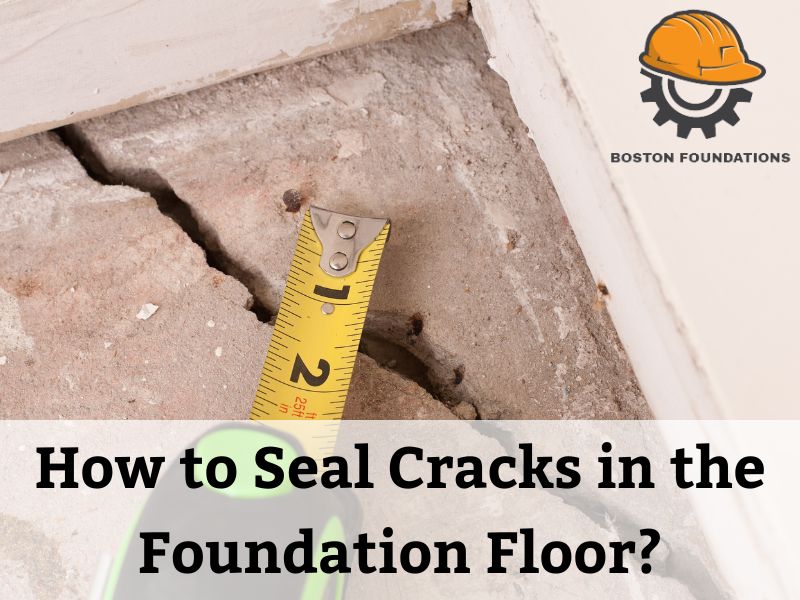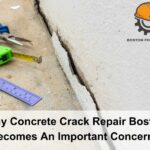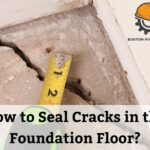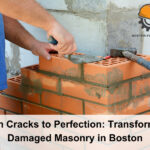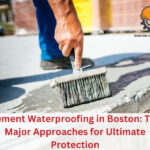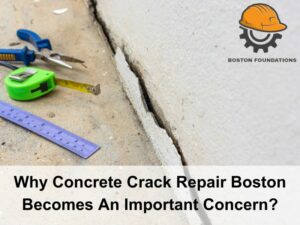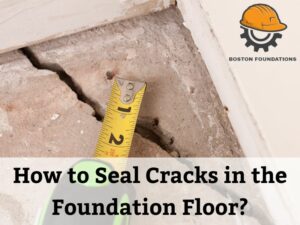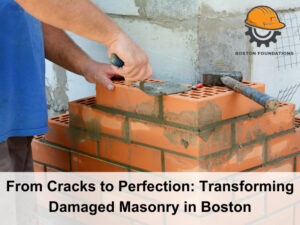Introduction:
Maintaining a structurally sound foundation is paramount for every homeowner in Boston. Ignoring foundation cracks can lead to costly consequences, including compromised structural integrity, moisture infiltration, and reduced property value. In this comprehensive blog post, our aim is to equip you with the knowledge needed to seal foundation crack effectively. We’ll delve into the causes of foundation cracks, discuss the types of damage you might encounter, and provide step-by-step guidance on assessing, sealing, and repairing them. So, let’s get started.
Understanding Foundation Floor Cracks
Foundation cracks can stem from various factors, with some of the most common causes being settling, water damage, and temperature fluctuations. In Boston, where weather extremes are a reality, temperature changes can significantly stress your foundation. Settling occurs as the soil beneath your home shifts over time, leading to cracks in the concrete. Additionally, water damage, often exacerbated by heavy rains and snowmelt, can seep into cracks, causing them to expand and worsen. Recognizing these causes is crucial to seal foundation crack Boston MA.
Consequences of Ignoring Foundation Cracks
Neglecting foundation cracks in Boston can lead to significant issues. It jeopardizes structural integrity, causing costly repairs, and allows moisture in, leading to mold growth and impacting indoor air quality. Furthermore, it can decrease property value, making selling or refinancing difficult.
When to Be Concerned: Assessing Foundation Cracks
When dealing with foundation cracks, it’s crucial to consider professional input to seal foundation cracks as your first step. A foundation contractor or structural engineer with expertise in foundation crack repair can provide invaluable insights. However, here are some guidelines to help you decide when to be concerned:
Hairline Cracks
These thin cracks, akin to a sewing thread, typically appear within a year of construction near windows, doors, or basement corners due to natural concrete settling. Fortunately, they are harmless and easily fixed with masonry paint.
Narrow Cracks (Up to ⅛ inch)
Cracks no wider than ⅛ inch may result from settling but aren’t problematic unless they expand. Monitor them by marking, dating, and periodic width measurements. If they remain stable, fill them with grout.
Large Cracks (Exceeding ½ inch)
If a crack surpasses ½ inch in width, seek a professional assessment to seal the foundation crack in Boston, MA. Larger cracks may hide underlying structural problems requiring expert attention.
Bulging Wall with a Crack
Even a slight bulge near a crack suggests a structural problem, often due to soil swelling from moisture. It’s vital to have a qualified Boston foundation repair contractor assess it.
Changes in Crack Direction
Cracks altering their direction or following mortar joints in a stair-step pattern signal shifting soil and varying foundation pressures. These cracks demand immediate expert evaluation.
Types of Sealants for Foundation Cracks
Let’s explore the various sealant options suitable to seal foundation cracks in Boston, MA.
Concrete-Compatible Caulk: Concrete-compatible caulk is an excellent choice for more minor cracks, typically up to ¼ inch wide. It provides a flexible and waterproof seal, ideal for hairline gaps and narrow crevasses that haven’t expanded.
Epoxy-Based Sealants: Epoxy-based sealants are a robust option for repairing foundation cracks, especially those between ¼ and ½ inch wide. They are known for their exceptional strength and durability. They are ideal for cracks that require a more rigid and long-lasting solution.
Polyurethane Sealants: Polyurethane sealants are versatile and suitable for various crack sizes, from narrow to moderate widths. They provide flexibility and excellent adhesion to concrete surfaces.
Acrylic Concrete Paint: Acrylic concrete paint primarily serves cosmetic purposes and can be applied to hairline cracks. While it may not provide the same structural reinforcement as other sealants, it can help improve the appearance of minor cracks and offer a basic level of protection against moisture.
When choosing the proper sealant for your foundation crack, consider the crack’s size and nature. Remember that for more extensive or concerning foundation cracks, it’s advisable to consult foundation crack repair specialists who can assess the situation and recommend the most appropriate one to seal foundation cracks effectively.
Step-by-Step Guide to Seal a Foundation Crack
Step 1: Repair a Foundation Crack With an Epoxy Sealer
An epoxy sealer can address a leaking foundation crack during heavy rainfall. Ensure the crack is dry before starting the repair. If there’s any moisture present, use a blow-dryer to dry it, and then wait for 15 minutes. Proceed with the repair only if the crack remains dry; if moisture returns, wait for it to dry naturally.
Step 2: Block Out the Injection Ports
Injection ports serve a critical purpose in the repair process. They provide access points for injecting the epoxy sealer into the crack. To prepare the crack for injection, you must clean it thoroughly. Use a wire brush or similar tool to remove loose debris or contaminants from the crack’s surface.
Step 3: Mix the Epoxy Sealer
Mixing the epoxy sealer is essential for a successful repair. Follow the manufacturer’s instructions on the epoxy product you’ve selected. You must mix equal parts of the epoxy resin and hardener thoroughly. Use a clean container and stir the components until you achieve a consistent color and texture.
Step 4: Attach the Injection Port
Attaching the injection ports is crucial to the repair’s success. These ports are typically made of plastic or similar materials and have adhesive backing. Place them along the crack, ensuring they are evenly spaced and firmly adhered.
Step 5: Spread Sealer Along the Crack
Mix a slightly larger batch of epoxy sealer and apply it to the entire crack using a 1 ½-inch-wide putty knife or margin trowel. Spread the sealer approximately 1/8 inch thick and extend it 1 inch on either side of the crack. Also, cover the entire flange of each injection port with crack sealer, leaving only the extended neck portion exposed.
Step 6: Inject the Epoxy into the Crack
Injecting the epoxy into the crack is a critical step in the repair process. You can use a specialized epoxy injection gun for this purpose. Start at one end of the crack and work to the other, gradually filling the gap with epoxy.
Step 7: Seal Up the Injection Ports
Sealing the injection ports becomes essential after injecting the epoxy and filling the crack. Remove any excess epoxy that may have oozed out during the injection process.
Step 8: Cut Away the Injection Ports
The final step in the repair process involves cutting away the injection ports. Use a utility knife or a similar tool to trim the ports flush with the surface. This step helps create a clean and finished appearance and ensures the repaired area is flush with the surrounding foundation.
DIY Vs. Professional Help for Foundation Cracks
Attempting DIY fixes for foundation problems is initially cost-effective and convenient. However, DIY solutions often need more expertise to seal foundation cracks effectively. Incorrect repairs can exacerbate issues and lead to costly damage and potential structural complications.
For the best foundation crack repair in Boston, MA don’t hesitate to explore! Search with phrases like ‘foundation repair near me‘ to find the most qualified experts. Experts possess the knowledge and tools to assess and address foundation cracks accurately, ensuring long-term stability and peace of mind.
Conclusion
In the ever-changing landscape of Boston, recognizing signs of foundation problems is paramount. It’s not just about safeguarding your investment; it’s about preserving the safety and comfort of your home. Professional Boston foundation repair specialists are the cornerstone of effective foundation problem resolution. They possess the knowledge, tools, and experience to assess and address issues, ensuring long-term stability accurately.
At “Boston Foundation Repair,” we are steadfastly committed to delivering top-notch foundation crack repair solutions. We understand your home’s foundation’s critical role in its stability, safety, and value. We execute every repair with precision and care, leaving no room for compromise, thanks to our dedication to excellence. Contact us today to schedule an assessment and take the first step toward ensuring the long-lasting stability of your home.
FAQ – Frequently Asked Questions
1. How much does it cost to seal foundation cracks in Boston, MA?
The cost varies based on factors like crack severity and foundation size. For precise estimates, consult local Boston foundation repair specialists.
2. What type of sealant should I use for foundation cracks?
Use a high-quality epoxy or polyurethane-based sealant for effective and long-lasting results. Consult a professional to determine the most suitable product for your specific crack.
3. What signs should I watch for after sealing foundation cracks?
After sealing, actively monitor for any reappearing cracks, water leaks, or changes in your home’s structural integrity. Timely detection ensures prompt addressing of issues.
5. How can I hire a professional to seal foundation crack Boston, MA?
To hire a reliable foundation crack repair in Boston MA, conduct online searches using keywords like “foundation repair near me” or seek recommendations from neighbors and friends.
6. How much time does it typically take to seal foundation cracks?
The duration depends on the extent of the damage and the chosen repair method. Simple repairs may take a few hours, while more complex cases could span a day or longer.

